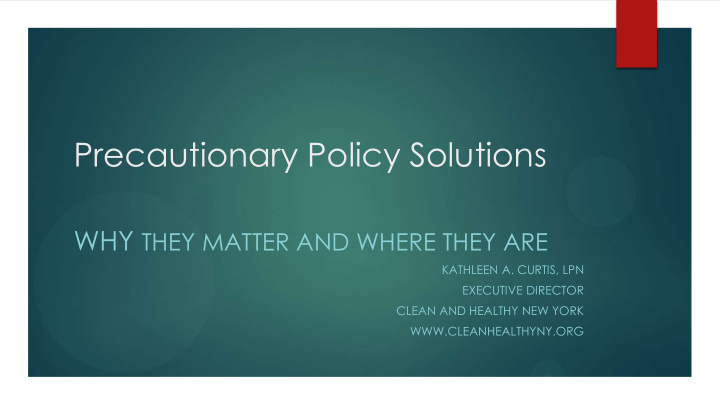



Precautionary Policy Solutions WHY THEY MATTER AND WHERE THEY ARE KATHLEEN A. CURTIS, LPN EXECUTIVE DIRECTOR CLEAN AND HEALTHY NEW YORK WWW.CLEANHEALTHYNY.ORG
Precautionary Principle in Policy Instead of the traditional question “How much harm is allowable?” the precautionary principle asks, “How little harm is possible ?” Four considerations should guide precautionary policy implementation: action to prevent harm despite uncertainty, shifting the burden of proof to proponents of a potentially harmful activity, examination of a full range of alternatives to potentially harmful activities, including no action, and democratic decision making to ensure inclusion of those affected.
International Precautionary Policies Cartagena Protocol on Biosafety of 2003 supports use of precautionary principle by countries importing genetically modified organisms Stockholm Convention on Persistent Organic Pollutants of 2001 uses the precautionary model for adding banned chemicals to its list The international trade harmonization schemes, such as the TPP and TAFTA are designed for economic liberalization and not for environmental protection or sustainable development
National Precautionary Policies – EU Each EU member state accepts precaution as a general principle of environmental policy The Danish Environmental Protection Agency held a national conference in 1998 to examine implementation of the principle The British, Scottish, and Swedish governments have been undergoing similar exercises Hungary and Brazil have adopted precaution as a guiding principle
National Precautionary Policies – US U.S. tend to avoid the words ‘Precautionary Principle’ Overall preference for cleaning up messes than preventing them Political system is influenced by corporate interests that oppose the use of precaution FDA requires all new drugs be tested before entering the market U.S. Commission on Ocean Policy recommended the adoption of a precautionary approach to managing the ocean environment EPA can stop marketing of a chemical and require testing if ‘…exposures are predicted to be significant…’ EPA’s DfE Program , although voluntary, uses hazard and alternatives assessment rather than risk assessment
What Implementation Looks Like The Danish government banned phthalates in toys designed for children under three without calculating risks quantitatively Instead, they based the decision on qualitative considerations: exposure was occurring; phthalates are toxic to laboratory animals; children may be uniquely susceptible to toxic substances; and alternatives were readily available.
State Precautionary Policies New Jersey : Adopted the School Integrated Pest Management Act that requires all schools to adopt an Integrated Pest Management policy plan, and notification system New York : Law requiring schools to purchase environmentally-sensitive cleaning and maintenance products that minimize adverse impacts on children’s health and the environment New York bill : Would enact the "New York state public health protection act"; establishes a precautionary policy for the state; establishes criteria to guide implementation of the precautionary policy; creates a precautionary policy planning council
Local Precautionary Policies City of San Francisco first in the nation Five elements: anticipatory action, right to know, alternatives assessment, full cost accounting, and participatory decision process City of Seattle Precautionary Policy (broad, diverse working group established precautionary principle as decision-making framework
Forward-thinking Precautionary Policy Comprehensive chemicals policy Enacted in several states: CA, ME, WA, VT Creates a precautionary framework for disclosing and regulating chemicals in consumer products Includes such precautionary favorites as right to know, alternatives assessments and hazard-based classification of chemicals Pending in several other states, such as NY and OR
Forward-thinking Precautionary Policy Flame-retardant chemical bans Eliminates the use of ten FR chemicals in upholstered furniture, children’s products Does not require proof of exposure, permissible levels of exposure, or other risk factors Allows for assessment of replacement chemicals prior to approval, further bans if chemicals found hazardous
Resources San Francisco Precautionary Principle Resolution http://www.sfgov.org/site/uploadedfiles/sffood/policy_reports/Precautionary%20Principle%20r01 29-03.pdf New York Green Schools http://www.ogs.state.ny.us/bldgadmin/environmental/default.html . New Jersey IPM Policy http://www.nj.gov/dep/enforcement/pcp/pcp-ipm.htm USEPA Design for the Environment Program http://www.epa.gov/dfe/ Wingspread Statement on the Precautionary Principle http://www.sehn.org/wing.html Louisville Charter for Safer Chemicals http://louisvillecharter.org/thecharter.shtml Public Health Protection Act http://open.nysenate.gov/legislation/bill/A281-2013 The Stockholm Convention on Persistent Organic Pollutants http://chm.pops.int/Home/tabid/2121/mctl/ViewDetails/EventModID/870/EventID/543/xmid/692 1/Default.aspx
Thank You! Kathy Curtis, Executive Director Clean and Healthy New York 518-461-1552 www.cleanhealthyny.org
Recommend
More recommend